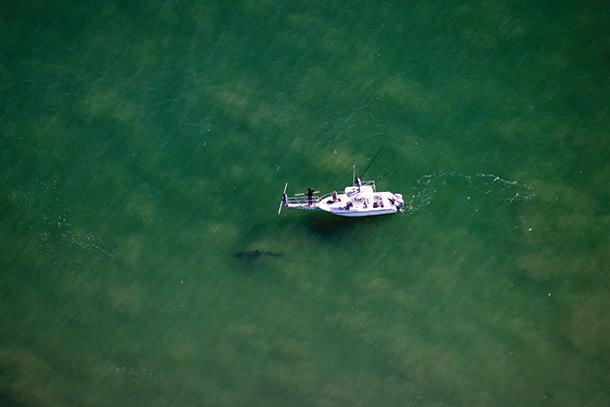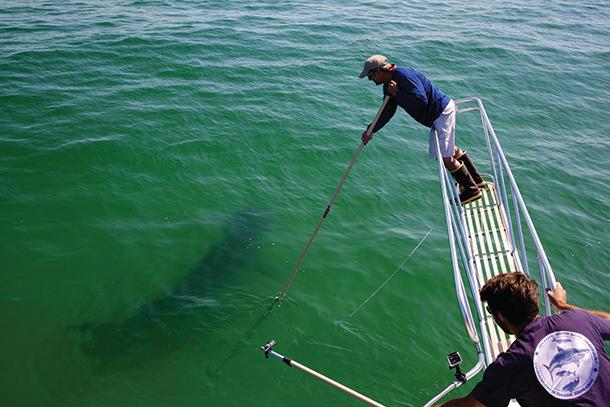The great white shark is a ‘knight in white and silver satin’
Despite sharks’ reputation as vicious creatures that will take a bite out of a human at every opportunity, our fear is a bit misplaced. The chance of getting bitten by any type of shark is about 1 in 37 million. Humans kill millions of sharks every year.
For many humans, the great white shark is the scariest fish in the sea. But for scientist Greg Skomal and writer Sy Montgomery, these huge-jawed behemoths are simply fascinating.
Montgomery, the author of 20 books on wildlife, followed Skomal and his team as they searched the waters off Cape Cod, Massachusetts, for these creatures. She and photographer Keith Ellenbogan tell the story in her latest book, "The Great White Shark Scientist."
Montgomery and Ellenbogen also went diving in a shark cage in Mexico, where the animals came within yards of them. Montgomery says when she saw her first great white coming toward her, she felt a profound sense of tranquility.
“When the animal looked at me, when I saw his eye swivel in its socket and look at my face, there was no malice at all,” she says. “I felt very calm, because here's this giant fish that has reigned over the seas for millennia. Only recently have humans taken charge, and we've done a terrible job. … But there I am, under the water, and I was just so glad to see someone showing up who knew what they were doing.”
They're incredibly beautiful too, Montgomery adds. “When you see them in the clear waters, like you can off Guadalupe, they look like a knight in white and silver satin. I mean, they're just gorgeous, sleek, clean, perfect animals.”
Finding a shark can be like finding a needle in a haystack. So Greg Skomal works in tandem with a spotter plane piloted by Wen Davis. Davis searches for the dark shape in the water and then radios the location to Skomal.

When Skomal finds a shark, he tries to record the animal from above and below, using a GoPro camera. Surprisingly, these huge, strong fish are very shy and spook easily, Montgomery says, so it's not an easy job to find them and get that crucial video. Skomal also wants to tag the sharks he finds and track their whereabouts.

“The tags allow him to figure out who was where when, and where they go,” Montgomery explains. “Some of them are hooked up to satellites, transmitting its location every time the shark comes near the surface, so you can plot out a map of where each shark has been.” There is also a series of buoys around the Cape that receive a ping when a shark swims nearby, indicating which shark visited that buoy and at what time.
Non-scientists can can follow the tagged sharks on a smartphone app or on ocearch.org. Several sharks even have their own Facebook page.
Great white sharks are not endangered, but other species of sharks are — and killing them can have big consequences for the ocean ecosystem.
“When you start messing with the numbers of apex predators, you wreck the whole balance of the ocean,” Montgomery explains. “In areas where this has been done and shark numbers have collapsed, it has created what is called a trophic cascade of disaster all the way down to where the quality of the water actually suffers.”
In one place where sharks were targeted specifically, the entire scallop industry for that area collapsed. “Sharks keep the predators of the scallops in order, and once you wreck that balance you can lose an entire fishery,” Montgomery explains. “Because scallops are filter feeders, [their absence] wrecks the quality of water. That's what happens when we knock out one of those building blocks that's supporting the health of our seas.”
Human fears of great whites are greatly exaggerated. They aren’t the least bit interested in eating humans, Montgomery says. On the rare occasion when a shark does bite a person, it spits them out, because it's a mistake.
“Think of it,” Montgomery says: “A delicious seal with all that yummy blubber — that’s like a steak and a piece of chocolate cake to a great white shark. But me, I'm the stringy piece of celery that's been sitting out on the counter all week. They are not going to want to eat me.”
The chance of being killed by a shark of any species is 1 in 37 million, whereas the chance that you will die of the flu is 1 in 63. You are far more likely to be injured by a room air freshener, a toaster or your toilet, Montgomery says.
“You can get conked on the head by the seat. If you're a little child, you could fall in and you could drown,” she points out. “These are extremely rare and freakish accidents, but far more rare and freakish is the chance that a Great White shark will ever hurt you.”
Still, no one wants to tempt fate, so Montgomery offers this advice: Don't swim too far out away from the beach, and don't go anywhere near seals. In 2012, a shark attacked a swimmer on Cape Cod. He was swimming near some seals and far from shore. It was the first attack on a person in Massachusetts in 76 years. He was hurt, but now he's fine, Montgomery says.
This article is based on an interview that aired on PRI’s Living on Earth with Steve Curwood
